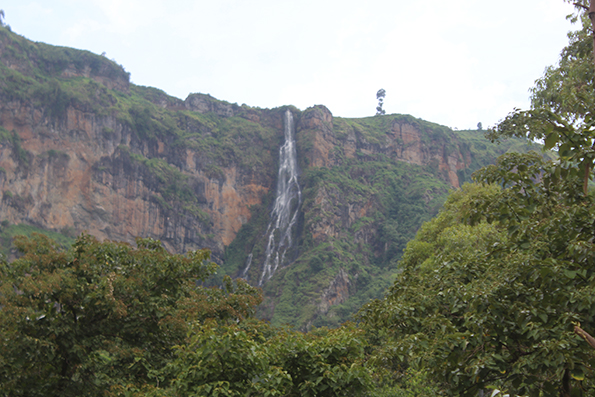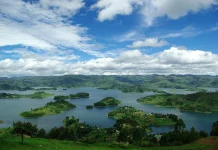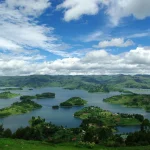Wanale ridge is located in Bumboi village, Busamaga parish, Bungokho-Mutoto sub-county Mbale district, Eastern Uganda. The trailhead for hiking Wanale is 16 km east of Mbale city via Busamaga primary school road. Wanale ridge rises 1,749 meters above sea level at the foothills of Mount Elgon, an extinct volcano that straddles the borders of Uganda and Kenya.
According to the U.S Geological Survey, Mt. Elgon was formed during the Pleistocene epoch almost 2.5 million years ago, making for one of the oldest volcanic mountains on earth. Geographers assert that Elgon was once the highest mountain in Africa, however. The volcano erupted and collapsed into its magma chamber leaving a large caldera which measures 6.5 km across.
The caldera’s floor contains swamps and several crater-filled freshwater lakes such as Jackson’s pool at 4,200 m.a.s.l. Mount Elgon is a source of over 8 rivers and 10 waterfalls including the famous Sipi falls in Kapchorwa district. Wanale is one of the biggest cliffs and contains the Namatsyo waterfalls where water cascades over the rocks. The west and north west slopes of Mount Elgon are characterized by unique physical features which include cliffs, deep valleys and gorges, ancient caves, and rocks.

The highest peak Wagagai stands at 4,321 meters above sea level and lies in Uganda’s Mount Elgon national park. Elgon is the 2nd tallest mountain in Uganda and 4th in East Africa. Climbing to the summit of Wagagai is done in Mount Elgon national park and takes 4-5 days. Trekking in Elgon requires no use of special equipment. Hikers need to carry camping gears. Mount Elgon national park comprises 4 vegetation zones which include acacia scrub with open expanses of grassland, montane forest, bamboo and afro-alpine.
The protected area was designated as a UNESCO Man and Biosphere Reserve due to the rich cultural heritage and biodiversity including 296 species of birds, over 30 mammal species, 273 tree species, and 171 butterfly species. Wanale offers a great day hike from Mbale for those with limited time to summit Wagagai. It also presents the opportunity to explore some of the flora and fauna. For instance, the endemic bearded vulture (Gypaetus barbatus), a unique bird of prey also known as the lammergeier.
You can also see some plant species like the ‘Artemisia’ plant, a medicine and repellent against malaria. The hike is ideal for those with moderate fitness levels and may take about 45 min – 1 hour to complete. Those intending to hike Wanale ridge should pack items like drinking water, packed lunch and snacks. A hiking stick, sturdy shoes and clothing depending on the day’s weather forecast. The falls that flow over the ridge form a subterranean river that flows through caves beneath the surface and re-emerges further downstream.
Hiking Wanale ridges also involves exploring the caves such as Khaukha cave which were used by the local communities living on the mountain in ancient times. There are four tribes that live on Mount Elgon which include the Bagisu and Sabinyi in Uganda and the Kalenjin and Babukusu on the Kenyan side. They’re closely related and speak relatively the same language. Wanale ridge lies outside the park within the Bagisu community which offers an opportunity to discover their traditions and history.

A memorable experience awaits with the help of a local tour guide from Mount Elgon national park. According to a local legend, the ridge was named after Wanale, one of the sons of Masaba, the founding father of the Bagisu people. He lived on the mountain and all his descendants refer to Elgon as Mount Masaba.
The Bagisu themselves are also known as the Bamasaba. One of their sacred ancient traditions is known as Imbalu, a circumcision ritual of initiating boys aged 16-22 years old into manhood. Imbalu features Kadodi, the traditional dance of the Bagisu and has been practiced for over 200 years. Held every year at Mutoto cultural site in Mbale city, Imbalu has become one of the biggest cultural festivals in Uganda. According to a local legend, Wanale hill is regarded as a place where Imbalu might have originated. The theory is also cited in a JSTOR Journal article titled: “The Historical origins of Circumcision Among the Bamasaba”
They lived by hunting game, gathering wild honey and food which wasn’t sustainable for long. They descended from the higher to the lower slopes of the mountain where the rich volcanic soil is fertile for farming. When the Europeans arrived, they introduced exotic animals and crops including Arabica coffee and white chicken. Wanale reared the white chickens and locally became well-known as Singokho, a local dialect meaning someone who likes white chicken.
While Wanale preferred to live around Elgon, one of his brothers called Kundu traveled from east to central and met the Baganda people who occupy the present day central part of Uganda. They admired his knowledge and geographical skills and accepted him as one of their leaders. Buganda emerged a powerful kingdom by the 19th century and the British declared it a protectorate in 1894. With British support, Buganda expanded and eventually subdued all other kingdoms to make Uganda.
One of the local chiefs of Buganda known as Semei Kakungulu was influenced to bring some of the Bagisu communities under the British. He established a residence near Mbale city and cultivated a new cult known as the Jewish community in Uganda. Kakungulu was fascinated by the beauty of Wanale ridge and gave it a new name Nkokonjeru to invoke the memory of white chickens that Wanale reared. Besides Wanale ridge, Mbale city is also home to over 20 historical buildings and monuments such as Semei Kakugulu’s House and camping site and Nabugoye Jewish Synagogue.












